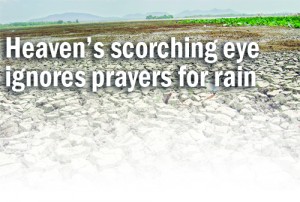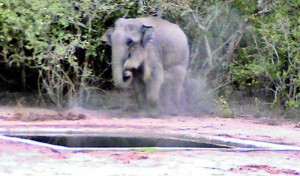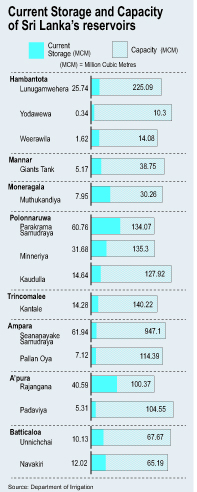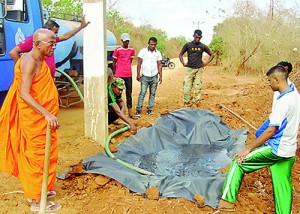News
Heaven’s scorching eye ignores prayers for rain
Thousands of villagers pray for rain as the ancient giant tanks and irrigation systems continue to dry up in 14 districts mostly in the North, East and North-Central provinces, with experts forecasting a continued need for trucked-in drinking water.
The famous 12th-century Parakrama Samudraya now has only one-fifteenth of the water it was built to hold.

A dried up tank in Yala
Although the Yala crop season has reached its end and the Maha season is to begin in October, water for domestic use as well as water for wildlife will be in short supply, with heavy rains not expected until late September.
Government Agents (District Secretaries) and irrigation and meteorological experts voiced the need for continued supplies of clean drinking water as well as for containers, barrels and tanks to hold water.
According to the Disaster Management Centre, more than 1.7 million people are suffering due to the prolonged drought.
In the Northern Province, with little rainfall since last year’s north-east monsoon, more than 300,000 people are short of adequate drinking water.
All districts in the North, Vavuniya, Mullaitivu, Mannar, Killinochchi and Jaffna are experiencing the severe dry spell, with the most affected being the Jaffna district’s Delft, Kayts, Maradankulam Karainagar, Velanai, Nallur and Karavaddi areas, Jaffna GA Suntharam Arumainayagam said.
Mannar too is badly hit, with no signs of rains for almost a year, especially in Mannar town, Madhu and Maanthai west, where drinking water supply is a concern for authorities.
In the Eastern Province, Ampara, Batticaloa, Trincomalee districts are also struggling although scattered rains were reported; more than 374,215 people are affected.
Although the south-western monsoon is expected to hit the Galle and Matara districts Hambantota is drought-affected, with both people and animals struggling to find drinking water. It was reported this week that crocodiles, including a 13-foot creature, were wandering into villages as water-courses dried up.
Polonnaruwa Government Agent Nimal Abeysiri said there have been many donations of plastic water tanks, water barrels and bottled water from private donors to be distributed in severely-affected areas such as Medirigiriya, Welikanda, Dimbulagala and other AGA divisions.
In the North Central Province about 200,000 people in the Anuradhapura and Polonnaruwa districts are going through hardship.
In the North Western Province more than 560,000 people in the Kurunegala and Puttalam districts are in hardship.
Irrigation Department Chief Badra Kamaladasa says water levels in reservoirs are falling at an alarming rate with an average holding of less than 14 per cent.
The Parakrama Samudraya in Ampara that has a capacity of 947 million cubic metres (MCM) currently holds only 61mcm. In Trincomalee, the Kantale tank, which can hold up to 140mcm, has dropped to only 14mcm.
In Polonnaruwa, the Minneriya tank has only 31mcm though the full capacity is 135mcm. Hambantota’s Irrigation Lunugamvehera tank, which can hold up to 225mcm, has only 25mcm. In Anuradhapura, the Padaviya reservoir that can hold up to 104mcm has only 5.31mcm.
The 72 major tanks in irrigable areas and other reservoirs have not received rainfall.
“Water for human consumption and for wildlife is becoming a growing concern,” Ms Kamaladasa said.

Kumana National Park: An elephant approaches a small tank that villagers have dug up to provide water to the animals
In drought-stricken areas, villagers are seen collecting fish from dried up streams and small water ways, and releasing them to rivers and tanks.
The Weheragala tank that provides water to both villagers and animals of Yala has gone down from 75mcm to 8.24mcm.
The Mau Ara reservoir that services the Uda Walawe National Park has dropped sharply from a total capacity of 40mcm to a mere 9mcm.
The rural Thanamalwila, Wellawaya, Buttala, Moneragala and Siyambalanduwa areas of Moneragala district have been experiencing great distress.
Villagers say though they receive water in bowsers with the elections nearing, long-term solutions such as reconstruction, de-silting and construction of tanks is needed to prevent crop loss and drinking water crisis in times of drought.
Moneragala GA A. Pathiananthan, said under the government’s Drought Recovery programme Rs 10 million was allocated to de-silt and reconstruct tanks. He said cash for work and food for work programmes are taking place in the district additional to the water being provided by bowsers of the army, water board and private hiring.
Ananda Perera, a senior meteorologist at the Meteorology Department, said the current south-west monsoon is a failure and that climate change was affecting weather patterns.
“Although Sri Lanka will not have direct effects from El Nino there is a possibility of experiencing indirect effects such as heavy rains in the coming second inter-monsoon starting in October or severe drought condition from March next year,” he said.
Mr. Perera said there would be scattered rain in the Hambantota, North Central and Eastern provinces but this would not provide sufficient drinking water nor fill up reservoirs.
| Monk, villagers ‘construct’ ponds for thirsty wildlife
A Buddhist monk and a veterinary surgeon have extended their kindness to save animals suffering from a water shortage in the Uva Province. He has made these ponds by digging up the dried lakes in Yala, laying polythene sheets on them, and filling them with water. Deer, monkeys and varieties of birds were seen approaching this new water pond to quench their thirst. Currently over 30 ponds have been made this way in Yala, Katagamuwa, Babowa and Heenwewa areas. The villagers have volunteered to refill the ponds when they dry out. Speaking to the Sunday Times, the Chief Monk said that he wanted to help the animals when some of them started to die. “It is a hard time for all of us. I wanted to help these animals and protect them from being destroyed because of the lack of water,” the Ven. Thera said. Meanwhile, Uva Province Wildlife officials had rescued two baby elephants suffering from kidney trouble. They had fallen sick after drinking muddy and contaminated water. Veterinary surgeon attached to the Uva and Central Province, Dr W.A. Darmakeerthi has been living in a small hut in Diyawara Village for the past three days, attending to the two baby elephants. Poor Yala season sends paddy prices up A drop in paddy production in the Yala season by about 50 per cent is forecast due to the continuing drought which has resulted in a rice shortage in the market while paddy prices have shot up, officials said. The competitive prices paid by private mill owners have resulted in the majority of farmers selling their paddy to large scale mill owners. Agriculture Ministry estimates of Yala season paddy production to drop down to 40 to 45 percent of the average yield, Mr. Meegasmulla said. The current market is already experiencing a shortage of local rice varieties already, he said. Most of the paddy farmers have been attracted to the private paddy millers. “As the farmers are getting high prices from mill owners we don’t get much stocks this year” PMB chairman K. B. Jayasinghe said. “On earlier occasions we supplied paddy from the PMB to the small and medium scale mill owners at guaranteed price. But this time we are unable to do so as the PMB is also not receiving paddy, due to higher prices paid by the large scale mill owners”, Cooperatives and Internal Trade Ministry spokesperson Nipuna Ekanayake said. The imported varieties are also being sold at the price ceiling imposed by the Ministry of Internal Trade, Mr. Ekanayake said. “We have to first see how much the Yala season production is before importing rice for the local market. Once the harvesting is completed we will imported the necessary quantity. Many of the supermarkets in Colombo have run short of red rice stocks, among other |


